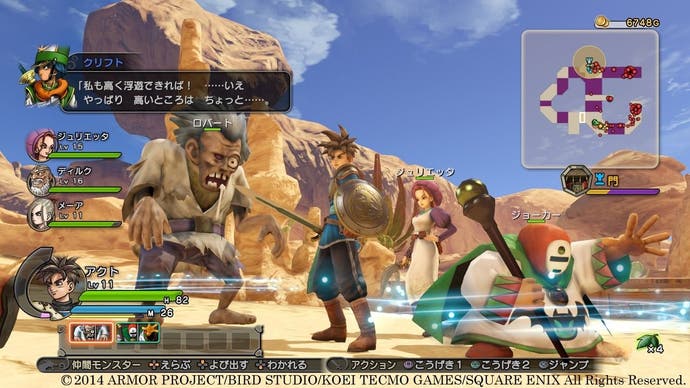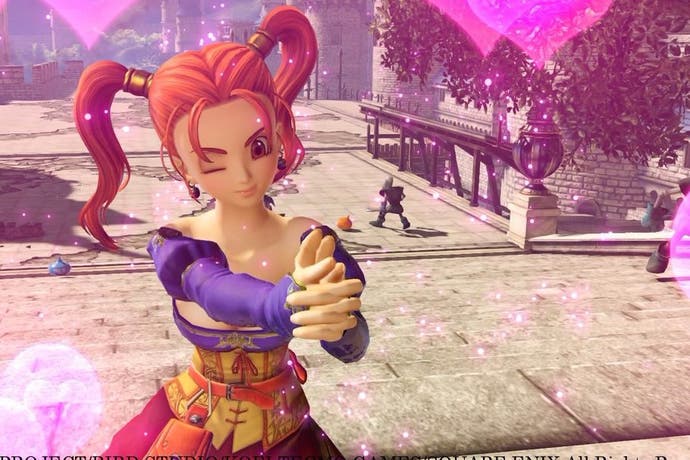Dragon Quest Heroes review
Subslime.
Editor's note: After a short delay Dragon Quest Heroes has made its way out of Japan and is releasing in the UK and EU this week. Here's Simon Parkin's original review, originally published in April, which we feel still reflects the game in its new, localised state.
Omega Force, the Japanese studio that popularised the outlandish 1 vs 10,000 historical battle simulator, has been mounting a novel strategy of late, one designed to lure players who have tired of (or stayed entirely away from) the Dynasty Warriors series onto the virtual battlefield. Hyrule Warriors was the studio's first alliance with a hitherto unrelated video game series, a successful sojourn into to the Zelda universe in the so-called 'Musou' style. There you played as one of Nintendo's velvety mascots, pirouetting about caverns and fields, attempting to control the ebb and flow of two opposing armies in a series of battles staged in familiar Hyrule. Now, with Dragon Quest Heroes, the studio has invaded an equally cherished and storied mythology, pitting a squadron of warriors from Square Enix's RPG series against illustrator Akira Toriyama's equally loveable enemy forces.
If Hyrule Warriors represented a softening of Omega Force's usual brittle style, in Dragon Quest Heroes the makeover is complete. Dragon Quest's cartoon aesthetic has been fully upheld. This is a grime-less world, its bright primary colours edged with resplendent gold. The sun sits immovable at high noon throughout the story, while the bouncing enemies (grinning blobs of slime, adorable miniature knights riding space hoppers, dragons you could curl up with as comfort toys) swipe at you, at all times maintaining cheery smiles. The tone is so relentlessly jolly you'll wonder why you can't call the whole thing off and settle down with a picnic to admire the view of the twinkling sea together instead. But beneath the joyous presentation, Omega Force's warmongering engine still purrs, hungrily.

You play as one of clutch of different heroes. Acht and Mehr are swordfighters (one boy, one girl) who fit the usual Dragon Quest protagonist's profile: young, quick and coiffured. Dirk, by contrast, is a hulk of a heavy-hitting king, able to clear great swathes of space with a sweep of his staff. Julietta, the fourth character in the starting line-up, is a mage who supports her team with strikes from her weaponised boomerang and the odd healing spell. As the game's story unfurls, you unlock other characters, most of who are taken from previous titles in the series, including fan favourites such as Jessica, Yangus and Meena.
Characters share a control scheme (and melee combos almost always end in a splash of combat magic, regardless of who you're controlling), but have wildly different move-sets, strengths and weaknesses and skill trees, which can be pruned to suit your tastes as you level each character up (as well as new moves you can spend points to unlock other abilities, and stat boosts). Contrary to most Musou games, you are able to switch between four chosen characters mid-battle. All characters appear on the battlefield at all times, with the computer controlling the supporting three roles. Generally you'll stick with your favourite avatar but the ability to leap between options can be useful for clearing distance quickly, or, if the AI is loitering, for issuing the odd support spell from a secondary character, or a screen-wrecking special move.
Multi-character control on the battlefield is just the first change to what represents a significant overhaul of the Musou template. The battles are far shorter than in any other Omega Force title to date. And while you must still defeat enemy generals now you must also, almost without exception, defend a home point from attack. Rather than working your way across the battlefield, claiming new areas to your army's side, the game becomes a more straightforward negotiation between attack and defence, in which you strike out to eliminate an enemy commander, before rapidly retreating to fend off attacking forces that have gathered around your home point. Most battles are finished in a great deal less than 15 minutes.

To add a layer of strategy to this more simplistic approach, you can now deploy minions to join in the fight, either as stationed defenders near your home point, or questing attackers, who trigger area-clearing special moves. Minions are represented by collectible coins, dropped by fallen enemies. Once you have the coin you can deploy a friendly version of the unit at will. While you have six minion slots to fill, more powerful minions will take up more than one slot. This leads to some micromanagement strategy, as you must choose how to balance your supporting monsters: with safety in numbers, or a couple of more powerful options. Later in the game it's possible to teleport around the battlefield between warp crystals, and mounted turrets provide further offensive possibilities.
Dragon Quest's familiar props and metaphors are maintained throughout: die during battle and you'll be resurrected in the local chapel, the same place at which you can save your game's progress. After the game's lingering introduction, you gain access to an airship (complete with a high street's worth of stores, and, ludicrously, the chapel itself), which you direct around a world map (it dutifully follows your cursor) while you choose where to land. Items can be combined in a stewing pot to create new goods and there's a side-quest desk at which you can pick-up a seemingly endless supply of extra-curricular missions: all familiar designs to Dragon Quest veterans. There are other neat flourishes, such as the ability to convert each of the game's 49 unlockable trophies into awards and power-ups, and the ripple of distant applause that encourages you every time you do something notable on the battlefield.
Omega Force celebrates Dragon Quest's rich and vibrant universe, and the quick-fire missions offer a welcome change of pace to a style of game that's synonymous with drawn out battles that can last more than an hour a time. But valuable things have been lost in the restructuring too. Combat lacks the pace and punch for which Dynasty Warriors et al are known. And in the more direct back and forth of offence and defence play, the sense of being a just one element in a storm of combat is lost. This is, as Square Enix labels it, more of a traditional action RPG than a churning battlefield simulator. Omega Force may gain some new supporters to its cause, but something vital has been traded in the endeavour.











